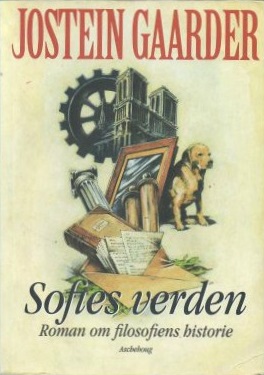Sophie’s World

Sophie’s World (Norwegian: Sofies verden) is a 1991 novel by Norwegian writer Jostein Gaarder. It follows Sophie Amundsen, a Norwegian teenager who is introduced to the history of philosophy by Alberto Knox, a middle-aged philosopher.[1]
Sophie’s World became a best-seller in Norway and won the Deutscher Jugendliteraturpreis in 1994. The English translation was published in 1995, and the book was reported to be the best-selling book in the world that year. By 2011, the novel had been translated into fifty-nine languages, with over forty million print copies sold.[2] It is one of the most commercially successful Norwegian novels outside of Norway, and has been adapted into a film and a PC game.
Sophie Amundsen is a 14-year-old girl who lives in Lillesand, Norway.
The book begins with Sophie receiving two messages in her mailbox and a postcard addressed to Hilde Møller Knag. Afterwards, she receives a packet of papers, part of a course in philosophy.
Sophie, without the knowledge of her mother, becomes the student of an old philosopher, Alberto Knox. Alberto teaches her about the history of philosophy. She gets a substantive and understandable review from the Pre-Socratics to Jean-Paul Sartre. In addition to this, Sophie and Alberto receive postcards addressed to a girl named Hilde from a man named Albert Knag. As time passes, Knag begins to hide birthday messages to Hilde in ever more impossible ways, including hiding one inside an unpeeled banana and making Alberto’s dog, Hermes, speak.
Eventually, through the philosophy of George Berkeley, Sophie and Alberto figure out that their entire world is a literary construction by Albert Knag as a present for Hilde, his daughter, on her 15th birthday. Hilde begins to read the manuscript but begins to turn against her father after he continues to meddle with Sophie’s life by sending fictional characters like Little Red Riding Hood and Ebenezer Scrooge to talk to her.
Alberto helps Sophie fight back against Knag’s control by teaching her everything he knows about philosophy, through the Renaissance, Romanticism, and Existentialism, as well as Darwinism and the ideas of Karl Marx. These take the form of long pages of text, and, later, monologues from Alberto. Alberto manages to concoct a plan so that he and Sophie can finally escape Albert’s imagination. The trick is performed on Midsummer’s Eve, during a “philosophical garden party” that Sophie and her mother arranged to celebrate Sophie’s fifteenth birthday. The party soon descends into chaos as Albert Knag lost his control over the world, causing the guests to react with indifference to extraordinary occurrences. Alberto informs everyone that their world is fictional but the guests react with rage, believing him to be instilling dangerous values in the children. When a Mercedes smashes into the garden, Alberto and Sophie use it as an opportunity to escape. Knag is so focused on writing about the car that he doesn’t notice them escaping into the real world.
Having finished the book, Hilde decides to help Sophie and Alberto get revenge on her father. Alberto and Sophie cannot interact with anything in the real world and cannot be seen by anyone but other fictional characters. A woman from Grimm’s Fairy Tales gives them food before they prepare to witness Knag’s return to Lillesand, Hilde’s home.
